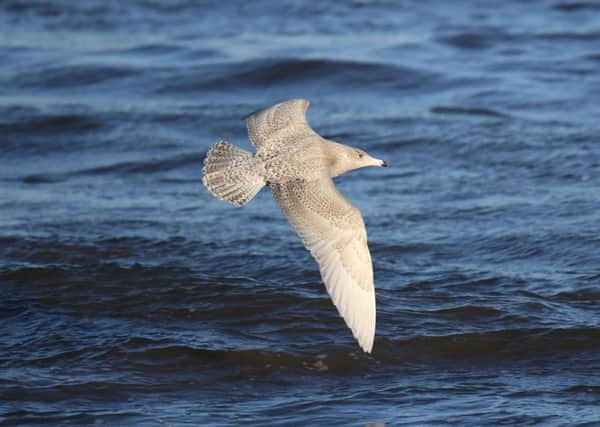Birdwatch: Distinctive gulls on the coast in the wake of tidal surge


The hoped for Ross’s or Ivory gull has so far failed to materialise but there were plenty of other ‘white-winged’ gulls with good numbers of glaucous and Iceland on the coast and inland. There was at least seven glaucous gulls in the Scarborough area on one day and more at other places.
Glaucous gulls are large, somewhere between a herring gull and great black-backed gull, and look fierce with their massive hooked beak and flat head.
Advertisement
Hide AdAdvertisement
Hide AdIceland gulls are generally smaller and daintier looking and another feature is that the wings are long and stretch out behind the bird when it is on the water or perched.
Adults in both species are white and pale grey while younger birds have a pale brown mottled plumage which makes them stand out.
At all ages both glaucous and Iceland lack the black wing tips of most other gull species.
The weather also brought more great northern and black and red throated divers further south with at least two sheltering in Filey Bay with a red-necked grebe while another two, along with two black-necked grebes, have continued to be seen in Scarborough harbour.
Advertisement
Hide AdAdvertisement
Hide AdMore long-tailed ducks were seen along the coast in what’s been an exceptional winter for them while others remained on Hornsea Mere, at Tophill Low, Pugney’s Country Park, Wakefield and on the St Aidan’s site, Leeds.
Seawatchers also reported pomarine and great skuas and a sooty shearwater and a little auk off Flamborough.
Two black redstarts were seen on rocks in Scarborough’s North Bay and 16 shore larks were back on a coastal field next to the Cleveland Way at Crook Ness.
In South Yorkshire a female dark-throated thrush was on the RSPB’s Adwick Washland reserve on Sunday and was reported there again this week. There have only been about 60 records in this country since 1950.
Advertisement
Hide AdAdvertisement
Hide AdMeanwhile the dusky thrush has continued to be seen around the Dukes Barn Activity Centre in the village of Beeley, Derbyshire.
Both have probably been in this country since October after being brought here by persistent easterly winds.
More white-fronted and tundra bean geese were reported across the region while four adult and two juvenile Bewick’s swans were seen with 110 whooper swans in fields near Wroot, North Lincolnshire.
A drake green-winged teal was first seen at the weekend on the Main Lake at the North Cave Wetlands.
Advertisement
Hide AdAdvertisement
Hide AdThe juvenile pallid harrier has continued to be seen at the Welwick Saltmarsh reserve near Patrington along with two hen and marsh harriers and short-eared owls - seven raptor species have been present there.
Waxwings are continuing to move south. Sightings of ringed waxwings should be reported to Raymond Duncan at [email protected]